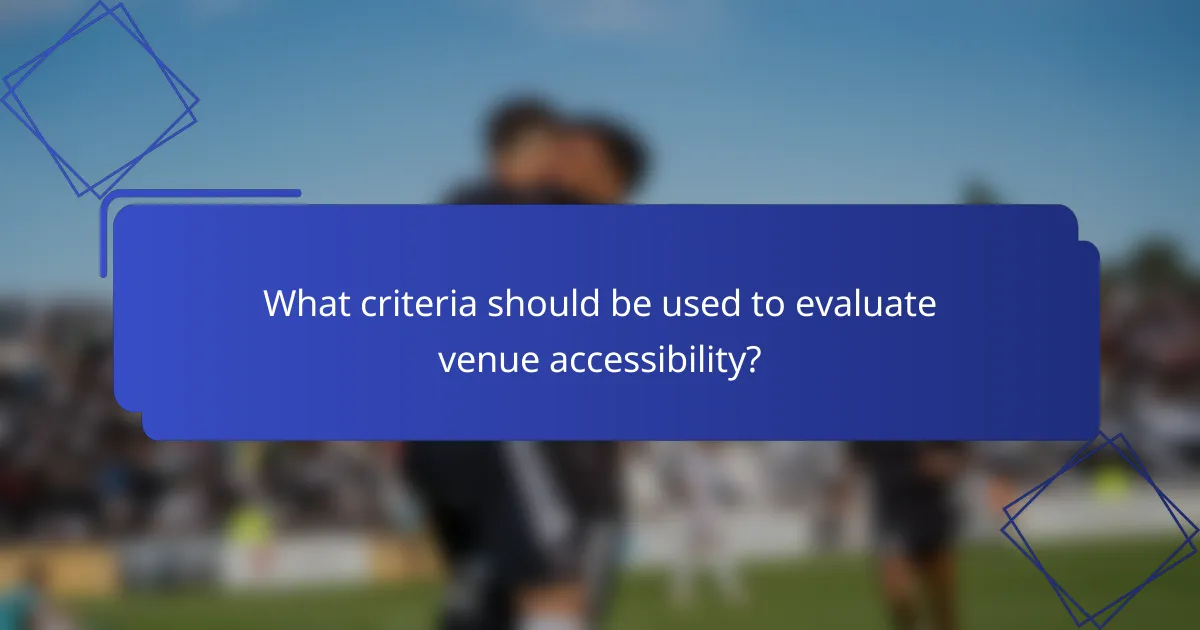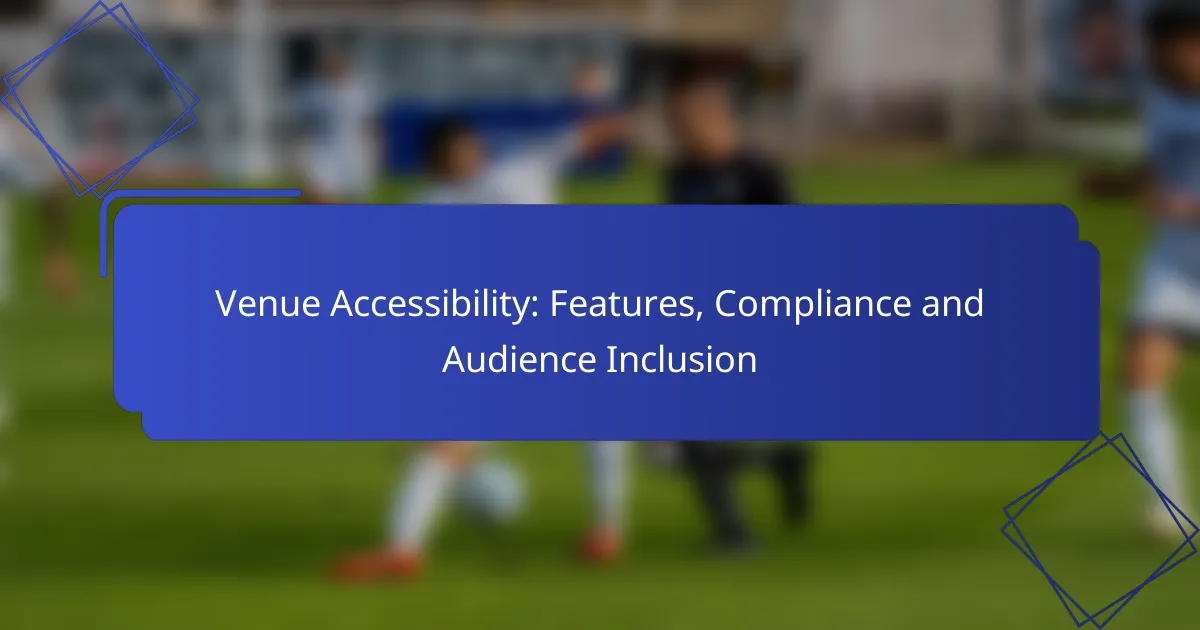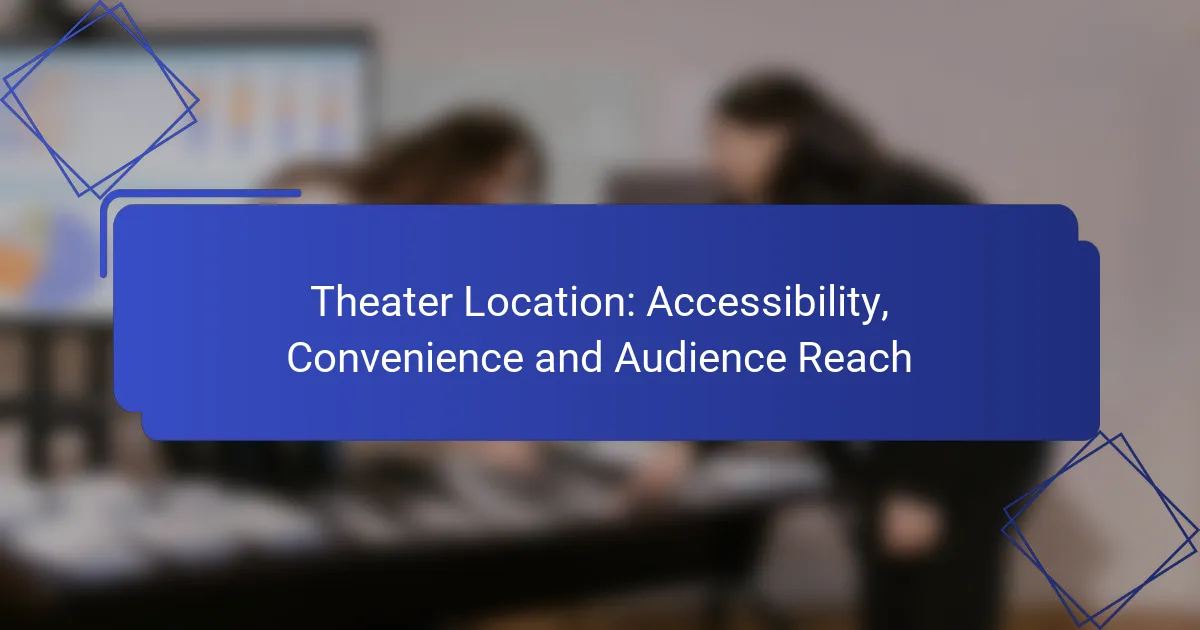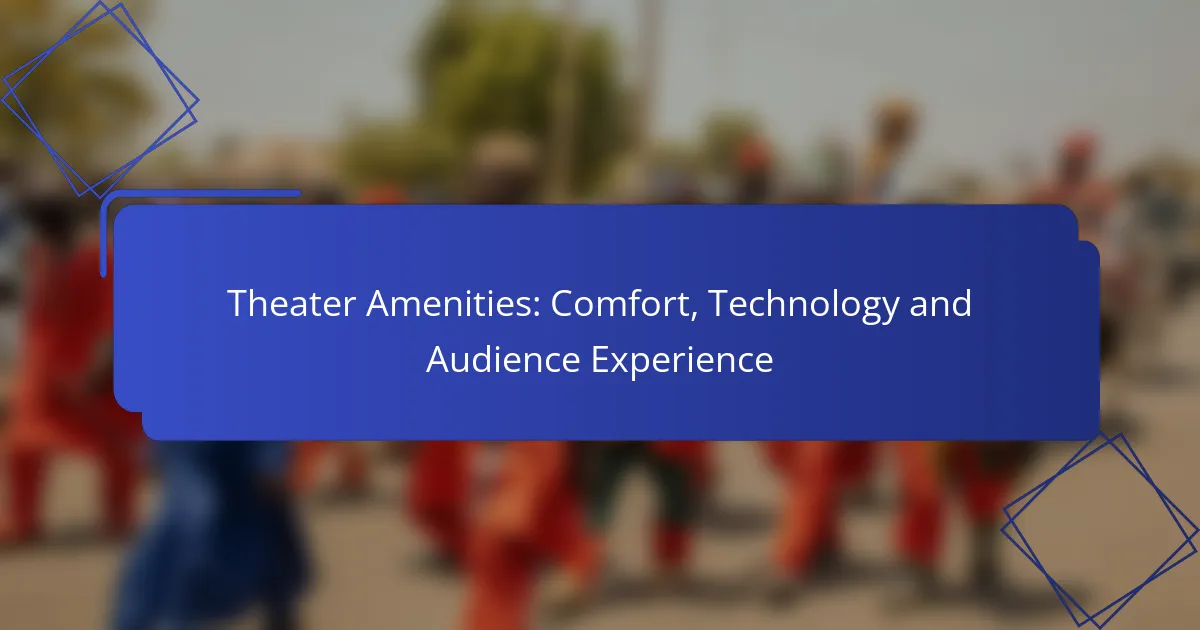Ensuring venue accessibility is crucial for accommodating individuals with disabilities, allowing them to navigate and engage fully in events. Key features such as wheelchair ramps, accessible restrooms, and assistive listening devices play a vital role in creating an inclusive environment. Compliance with established accessibility standards further enhances audience inclusion, fostering a sense of belonging and encouraging diverse participation.

What are the key features of accessible venues?
Accessible venues are designed to accommodate individuals with disabilities, ensuring they can navigate and participate fully. Key features include wheelchair ramps, accessible restrooms, clear signage, seating accommodations, and assistive listening devices.
Wheelchair ramps
Wheelchair ramps provide essential access for individuals who use wheelchairs or have mobility challenges. These ramps should have a gentle slope, typically no steeper than 1:12, to ensure safe navigation. It’s crucial to ensure that ramps are free from obstacles and have non-slip surfaces.
When planning a venue, consider the placement of ramps at all entrances and exits. Regular maintenance is necessary to keep them in good condition, preventing hazards like cracks or debris accumulation.
Accessible restrooms
Accessible restrooms are vital for venues to support individuals with disabilities. These facilities should be equipped with wider stalls, grab bars, and accessible sinks to accommodate wheelchair users comfortably. The layout should allow for easy maneuverability.
It’s important to ensure that accessible restrooms are clearly marked and located conveniently throughout the venue. Regular checks can help maintain cleanliness and functionality, ensuring they meet the needs of all users.
Signage and wayfinding
Effective signage and wayfinding systems are crucial for helping individuals navigate accessible venues. Signs should be clear, with large, legible fonts and symbols, and include Braille for those with visual impairments. Placement at eye level and in well-lit areas enhances visibility.
Consider incorporating digital wayfinding solutions, such as apps or interactive kiosks, to provide real-time information about accessible routes and facilities. This can significantly improve the experience for all attendees.
Seating accommodations
Seating accommodations are essential for ensuring that individuals with disabilities can enjoy events comfortably. Venues should offer designated accessible seating areas that provide clear sightlines and easy access. These areas should be integrated into the overall seating plan.
It’s advisable to allow for companion seating next to accessible spots, ensuring that friends or family members can sit together. Regularly reviewing seating arrangements can help identify and address potential accessibility issues.
Assistive listening devices
Assistive listening devices enhance the experience for individuals with hearing impairments by amplifying sound. Venues should provide options such as hearing loops, FM systems, or infrared systems to cater to diverse needs. These devices should be easily accessible and well-maintained.
Training staff on how to operate and distribute these devices can improve service quality. Additionally, promoting the availability of assistive listening options in event materials can help attendees plan accordingly and ensure they have a positive experience.

How do venues ensure compliance with accessibility standards?
Venues ensure compliance with accessibility standards by adhering to established regulations and guidelines that promote inclusivity for individuals with disabilities. This involves implementing physical modifications, training staff, and conducting regular assessments to maintain compliance.
Americans with Disabilities Act (ADA) guidelines
The Americans with Disabilities Act (ADA) sets forth specific requirements for public venues to ensure accessibility. These guidelines cover various aspects, including wheelchair ramps, accessible restrooms, and designated seating areas for individuals with mobility challenges.
Venues must provide clear signage, maintain accessible pathways, and ensure that services are available to all patrons. Regular training for staff on ADA compliance is essential to enhance customer service and support for individuals with disabilities.
Local building codes
Local building codes often complement ADA guidelines by establishing additional requirements tailored to specific regions. These codes may dictate the minimum number of accessible parking spaces, the slope of ramps, or the dimensions of doorways and hallways.
Venues should familiarize themselves with local regulations to avoid potential fines and ensure they meet community standards. Consulting with local authorities during the planning and construction phases can help identify necessary modifications early on.
Regular accessibility audits
Conducting regular accessibility audits is crucial for venues to maintain compliance with both ADA guidelines and local building codes. These audits assess the current state of accessibility features and identify areas for improvement.
Venues should schedule audits at least annually and after any significant renovations. Engaging third-party accessibility experts can provide an objective evaluation and help develop an actionable plan for enhancements, ensuring ongoing compliance and inclusivity.

What are the benefits of inclusive venues for audiences?
Inclusive venues offer significant advantages for audiences by ensuring accessibility and comfort for all individuals, regardless of their abilities. This approach not only fosters a sense of belonging but also encourages diverse participation in events and activities.
Increased attendance
When venues prioritize inclusivity, they attract a broader audience, including individuals with disabilities and their families. Accessible features such as ramps, elevators, and designated seating can lead to higher attendance rates, as more people feel welcome and able to participate.
For example, venues that implement comprehensive accessibility measures may see attendance increases ranging from 10% to 30%, depending on the community’s demographics and needs. This boost can significantly enhance the overall success of events held at these locations.
Enhanced community reputation
Inclusive venues contribute positively to their community’s reputation by demonstrating a commitment to diversity and equality. When a venue is known for being accessible, it builds trust and goodwill among local residents and organizations.
Moreover, venues that actively promote inclusivity often receive recognition from advocacy groups and may even qualify for awards or certifications. This recognition can further solidify their standing as leaders in community engagement and social responsibility.
Improved customer satisfaction
Customer satisfaction tends to increase in inclusive venues as attendees experience a more comfortable and accommodating environment. Features like accessible restrooms, clear signage, and trained staff can significantly enhance the overall experience for all guests.
Surveys indicate that patrons are more likely to return to venues that prioritize accessibility, leading to repeat business and positive word-of-mouth referrals. Ensuring that all audience members feel valued and respected is essential for fostering long-term loyalty and satisfaction.

What criteria should be used to evaluate venue accessibility?
To evaluate venue accessibility, consider physical access, communication access, and service animal policies. These criteria ensure that all individuals, regardless of their abilities, can participate fully in events and activities hosted at the venue.
Physical access
Physical access refers to the ability of individuals to navigate the venue without barriers. This includes features such as ramps, elevators, and accessible restrooms. Venues should comply with local regulations, such as the Americans with Disabilities Act (ADA) in the United States, which outlines specific requirements for accessibility.
When assessing physical access, check for clear pathways, adequate signage, and designated parking spaces. Consider conducting an on-site evaluation to identify any potential obstacles that could hinder movement, such as uneven surfaces or narrow doorways.
Communication access
Communication access ensures that information is available to all attendees, including those with hearing or vision impairments. This can involve providing materials in alternative formats, such as braille or large print, and offering assistive listening devices during events.
Consider the use of sign language interpreters or captioning services for presentations and announcements. Venues should also ensure that staff are trained to assist individuals with communication needs effectively.
Service animal policies
Service animal policies dictate how venues accommodate individuals who rely on service animals for assistance. Under the ADA, service animals are defined as dogs that are specifically trained to perform tasks for individuals with disabilities.
Venues should have clear policies that allow service animals to accompany their handlers in all areas where the public is allowed. It’s essential to communicate these policies to staff and ensure they understand the rights of individuals with service animals to prevent any misunderstandings.

How can venues improve audience inclusion?
Venues can enhance audience inclusion by implementing accessible features, ensuring compliance with regulations, and actively engaging diverse audiences. This involves creating an environment that accommodates various needs, fostering participation, and providing equal opportunities for all attendees.
Accessible Facilities
Accessible facilities are crucial for audience inclusion. This includes features such as ramps, elevators, and designated seating areas for individuals with mobility challenges. Venues should ensure that restrooms are equipped with accessible stalls and that pathways are clear and well-maintained.
In addition to physical access, venues should consider auditory and visual aids, such as hearing loops and captioning services, to support individuals with hearing or vision impairments. Providing clear signage in multiple formats can also help guide all attendees effectively.
Compliance with Regulations
Compliance with local accessibility regulations is essential for venues aiming to improve audience inclusion. In the United States, the Americans with Disabilities Act (ADA) sets forth requirements for public spaces, while in the European Union, the Accessibility Act outlines similar standards. Venues should regularly review these regulations to ensure they meet or exceed the minimum requirements.
Regular audits and assessments can help identify areas needing improvement. Engaging with accessibility consultants can provide valuable insights and recommendations for compliance and enhancement of facilities.
Engaging Diverse Audiences
Engaging diverse audiences involves understanding and addressing the unique needs of different groups. Venues can host events that cater to various cultural backgrounds, age groups, and abilities, ensuring that programming is inclusive and representative.
Offering flexible ticketing options, such as reduced-price tickets for low-income individuals or free admission for caregivers, can also promote wider participation. Additionally, actively soliciting feedback from attendees can help venues continuously improve their inclusivity efforts.



